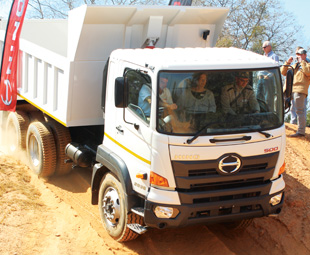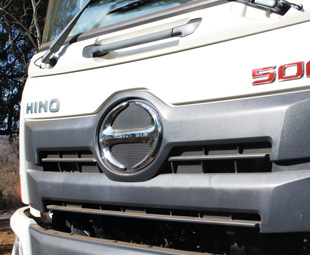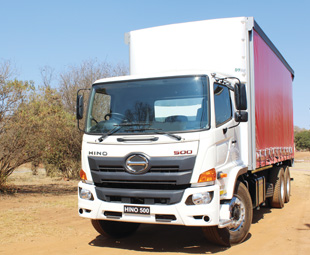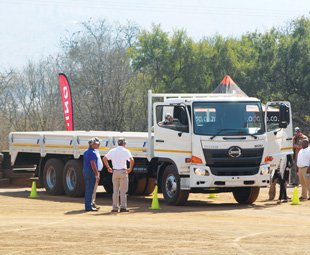Widening its appeal

You’ve already read Charleen Clarke’s driving impression of the new Hino 500 Series Wide Cab on page 22, now GAVIN MYERS reports on the South African launch to find out what local buyers can expect
Can you believe it’s been 15 years since the current Hino 500 Series made its debut? During that time, it’s consistently been among the top-selling models for Hino South Africa.
Even with the imminent launch of the 500 Wide Cab (it’ll officially be in Hino showrooms from November), demand for the current model is still strong – allowing the brand to exceed its own heavy commercial vehicle sales targets for the first half of the year, says Leslie Long, senior manager marketing and product planning.
While the current model won’t completely disappear from the local line-up just yet (certain key models will remain and receive some spec upgrades in January 2018), the initial 12-model 500 Wide Cab range clearly has a lot to live up to.
 According to product planner Donald Mokoena, customer input has strongly guided the development of the new models. Furthermore, while the J08E engines remain the same (with up to 12-percent more power and 19,5-percent more torque), the rest of the vehicle is all new.
According to product planner Donald Mokoena, customer input has strongly guided the development of the new models. Furthermore, while the J08E engines remain the same (with up to 12-percent more power and 19,5-percent more torque), the rest of the vehicle is all new.
“We are now competing in markets in which we’ve never been before. The new models weigh in between 16 and 28 t; with 270, 290 and 360 hp (191, 206 and 257 kW) Euro-3 engines in 4×2, 6×2 and 6×4 configurations,” Mokoena alludes.
The most obvious change is the visual one … the striking new cab is available in on-road and off-road configurations – both with high and low profiles. Two crew-cab variants will join the line-up early in 2019.
The cabs have been designed for easier, safer access and high levels of comfort. They feature either semi-floating or full-floating mountings (6×4 only), and the effects of both are clearly noticeable even when you’re not in the air-suspended driver’s seat.
Speaking of being inside the cabs, a range of comfort and convenience features is standard – including air-conditioning, cruise control, power windows and a radio (Long alludes to the possibility of Bluetooth hands-free connectivity being added in time). A driver airbag is standard, too, as are anti-lock brakes and Hino Easy Start Hill Assist.
 With its selectable quick or slow release, the effectiveness of this system was undeniable as we attacked an off-road course; it holding the vehicles still as they dug into the soft sand for traction and pulled away from an incline start. This system is only available with the six- and nine-speed manual gearboxes – yes, Hino is now also offering Allison six-speed autos on the 4×2 and 6×2 freight carrier models.
With its selectable quick or slow release, the effectiveness of this system was undeniable as we attacked an off-road course; it holding the vehicles still as they dug into the soft sand for traction and pulled away from an incline start. This system is only available with the six- and nine-speed manual gearboxes – yes, Hino is now also offering Allison six-speed autos on the 4×2 and 6×2 freight carrier models.
Another first for the 500 is the fitment of rear air suspension, which can be raised or lowered to tilt the body for easier loading or unloading of cargo. Trunnion suspension on the 6x4s allows for the fitment of a Cross Differential Lock System, which shuffles power between axles and wheels. To further aid occupant comfort, the front suspension leaves have been lengthened by 55 mm, while the front axle has been strengthened to allow for an extra tonne of loading capacity.
Hino’s aim of enhanced quality, durability and reliability with the new 500 has resulted in a few nifty features, too. For example, the chassis rail is wider at the front and narrower at the back for enhanced stability and manoeuvrability and its crossmembers are no longer riveted in place, but bolted, which allows for more accurate – and customised – fitting of bodies.
 An insect screen and belly plate have been fitted to keep the radiator clear and reduce the chance of overheating (the radiator core is also now 65 mm wider).
An insect screen and belly plate have been fitted to keep the radiator clear and reduce the chance of overheating (the radiator core is also now 65 mm wider).
With the new Hino 500 Series Wide Cab playing in both the heavy and extra-heavy segments, it’s clear that the company is even more determined to build on the success of the current model. The new range undoubtedly has what it takes.
As Long concludes: “The Hino brand aims to provide certainty in an uncertain world with tough products that are the choice of tough customers!”
Published by
Focus on Transport
focusmagsa




